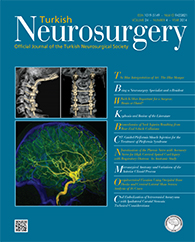MATERIAL and METHODS: Seventeen patients who underwent surgical treatment for orbital tumors by transcranial and transnasal approaches between 2008 and 2013 were analyzed retrospectively. Twelve of them were male and 5 were female. The mean age was 41.6 years. Neuronavigation systems were used in all cases. Four patients were operated using intraoperative imaging systems.
RESULTS: The transcranial approach was used in 9 (53%) patients, endoscopic medial orbital approach in 4 (23.5%), endoscopic inferolateral approach in 1 (6%), cranioorbitozygomatic approach in 1, lateral approach in 1, and the combined (medial endoscopic and lateral) approach in 1 patients. Total resection was achieved in 5 patients, gross total excision in 2, subtotal in 9 and partial in 1 patients.
CONCLUSION: Modern technology has made a significant contribution to the treatment of orbital tumors. Although technological equipments facilitate the excision of tumors, the level of resection is mainly determined by the nature of tumor and adhesion to the adjacent neurovascular structures. It should not be forgotten that advanced technology never replaces a good anatomical knowledge and surgical experience, but has a complementary role.
Keywords : Orbital tumor, Surgery, Endoscopy, Navigation, Intraoperative imaging




